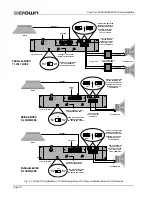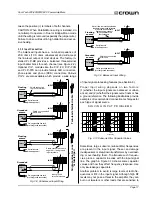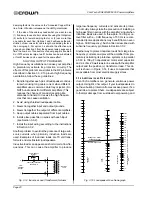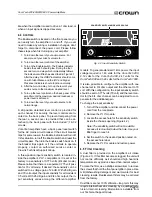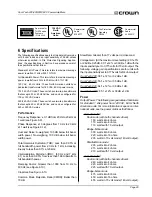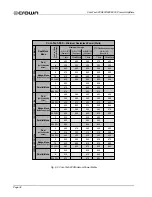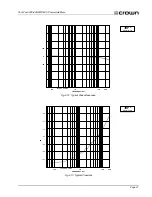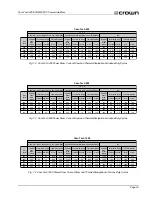
Page 30
Com-Tech 200/400/800/1600 Power Amplifiers
Controls
Enable:
A front panel rocker switch used to turn the
amplifier on and off.
Level:
A detented 22-position back panel level control
for each channel.
Output Mode:
A back panel switch for each channel
used to select 8/4 ohm or 70 volt output.
Dual/Mono:
A three-position back panel switch used to
select Dual, Bridge-Mono or Parallel-Mono operation.
Reset:
A back panel push button used to reset the
amplifier’s AC mains breaker.
Sensitivity:
A three-position switch inside the
P.I.P. com-
partment used to select an input sensitivity for both
channels: 0.775 volts for standard 1 kHz power in 8/4
ohm mode, 0.775 volts for standard 1 kHz power in 70
volt mode, or a voltage gain of 26 dB (see Section 4.4).
Indicators
Enable:
This amber indicator shows the on/off status of
the unit’s low-voltage power supply.
Signal Presence (SPI):
Each channel has a green indi-
cator that flashes to show audio output.
IOC :
Each channel has a yellow indicator that flashes if
the output waveform differs from the input waveform by
0.05% or more. The LEDs act as sensitive distortion indi-
cators to provide
proof of distortion-free performance.
In
Parallel-Mono mode, the channel 2
IOC indicator stays
on.
ODEP :
Each channel has a green multifunction indi-
cator that shows the channel’s reserve energy status.
Normally, the LEDs are brightly lit to show that reserve
energy is available. In the rare event that a channel has
no reserve, its indicator will dim in proportion to
ODEP
limiting. An
ODEP indicator may also turn off under
other more unusual circumstances (see Section 4.2).
Input/Output
Input Connector:
A barrier block on the standard
P.I.P.-
BB with three-terminal balanced connections for input
to each channel.
Input Impedance:
Nominally 20 K ohms, balanced.
Nominally 10 K ohms, unbalanced.
Input Sensitivity:
Settings include 0.775 volts for 8/4
ohm output, 0.775 volts for 70 volt output, and a volt-
age gain of 26 dB.
Output Connector:
A back panel barrier block with two-
Parallel-Mono mode:
440 watts into 2 ohms.
440 watts into 4 ohms.
455 watts with 70 volt output.
Com-Tech 800
Dual mode (with both channels driven):
490 watts into 4 ohms.
305 watts into 8 ohms.
460 watts with 70 volt output.
Bridge-Mono mode:
975 watts into 8 ohms.
610 watts into 16 ohms.
920 watts in 70 volt mode (140 volt output).
Parallel-Mono mode:
965 watts into 2 ohms.
610 watts into 4 ohms.
915 watts with 70 volt output.
Com-Tech 1600
Dual mode (with both channels driven):
870 watts into 4 ohms.
540 watts into 8 ohms.
960 watts with 70 volt output.
Bridge-Mono mode:
1,745 watts into 8 ohms.
1,080 watts into 16 ohms.
1,805 watts in 70 volt mode (140 volt output).
Parallel-Mono mode:
1,745 watts into 2 ohms.
1,080 watts into 4 ohms.
1,780 watts with 70 volt output.
It is extremely important to supply the amplifier with ad-
equate AC power. Power amplifiers cannot create en-
ergy—they need the required voltage and current
to
deliver the undistorted rated wattages you expect.
Load Impedance:
Safe with all types of loads. With 8/4
ohm output, all
Com-Techs are rated for 4 to 8 ohms in
Dual mode, 8 to 16 ohms in Bridge-Mono mode, and 2
to 4 ohms in Parallel-Mono mode. With 70 volt output,
rated loads vary among the different models for each
dual/mono mode (see the power matrices that follow).
Required AC Mains:
All units draws 90 watts or less at
idle. See Section 7 for detailed information on AC
power draw, current draw and thermal dissipation.
Low-Voltage Power Supply:
±15 VDC regulated sup-
plies are provided by a winding on the AC mains
power transformer.
Power Cord:
An appropriate AC line cord is provided
with a minimum cable length of 5 feet (see Section 2).

